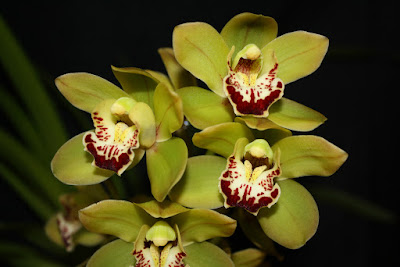Cymbidium Sessa Green Beauty is an epiphyte with egg-shaped pseudobulbs, 8 cm long and 5-5.5 cm wide, covered with 3-5 pairs of leaves, grow quite tightly to each other. The leaves are medium to light green in color, in direct sunlight they acquire a yellowish tint, 60-65 cm long and 3.5 cm wide.
Cymbidium Sessa Green Beauty is a hybrid between Cymbidium Stanley Fouraker (Cymbidium Alexanderi (Cymbidium Edward Marshall (Cymbidium Albatross (Cymbidium Gottianum (Cymbidium eburneum × Cymbidium insigne) × Cymbidium hookerianum) × Cymbidium Doris (Cymbidium insigne × Cymbidium tracyanum)) × Cymbidium erythrostylum) × Cymbidium Early Bird (Cymbidium Veitchii (Cymbidium eburneum × Cymbidium lowianum) × Cymbidium insigne)) and Cymbidium hookerianum. This hybrid was registerd by S.N.Hegde in Feb-23-2001 (Royal Horticultural Society).
IDENTIFY CYMBIDIUM SESSA GREEN BEAUTY PLANT
Cymbidium Sessa Green Beauty is an epiphyte with egg-shaped pseudobulbs, 8 cm long and 5-5.5 cm wide, covered with 3-5 pairs of leaves, grow quite tightly to each other. The leaves are medium to light green in color, in direct sunlight they acquire a yellowish tint, 60-65 cm long and 3.5 cm wide.
The peduncles appear at the base of the still not fully formed pseudobulb, often long before the bottom of a new sprout begins to round off (the earliest when a new sprout reaches a size of 30 cm in length). For each individual pseudobulbs there are 2 flower stems.
This cymbidium hybrid blooms from late winter through summer. The flowers are green with a small amount of red on the tepali, measuring about 6-7 cm in diameter, lasts 4-6 weeks. The lip is basically white, closer to the edge is covered with red spots.
CYMBIDIUM SESSA GREEN BEAUTY PLANT CARE AND CULTURE
Cultural information should only be used as a guide, and should be to be adapted to suit you. Your physical location; where you grow your plants, how much time you have to devote to their care, and many other factors, will need to be taken into account. Only then can you decide on the cultural methods that best suit you and your plants.
Light:
Cymbidium Sessa Green Beauty loves the bright sun without access to direct sunlight, so during the hot afternoon sun on the windows of the southern orientation and the hot evening sun on the western windows, the orchid should be placed behind the curtain or in the shade of other plants. Under very intense light, the leaves and pseudobulbs of the plant become yellowish. Good lighting is especially important during the period of growing of flower stalks and bud formation, since if the light in this period is insufficient, the flower stalks may dry out or throw off unopened flower buds.
Temperature:
This Cymbidium hybrid can be grown in cool to warm temperature. Throughout the year it is recommended to keep this orchids under the following conditions: day up to 32 ° C; night 5-15 ° C. For successful cultivation at home, it is necessary that the night temperature should always be 8-15 ° C lower than the daily one.
Humidity:
This hybrid does not need an extremely high humidity, and its rate can vary from 40 to 60%. Too dry air has a negative effect on the overall development of the plant - its growth is inhibited, and the leaves may turn yellow and dry out. The higher temperature, the higher the humidity should be, and the higher the humidity, the more often and longer it is necessary to ventilate the room where the plant are contained, otherwise the probability of rotting and leaves of various fungal diseases.
Substrate and growing media:
Cause of rather large sizes, Cymbidium Sessa Green Beauty is grown exclusively in ordinary (non-transparent) plastic pots, which are put into massive clay pots to give the plant stability. Any commercial mixture based on bark, peat and moss sphagnum is suitable as a substrate.
The plant no need for frequent transplantations, therefore, it is desirable to transplant this orchid only in cases of strong salinization or compaction of the substrate, at its critically high or low pH (above 6.5) or when the plant grows very strongly and the pot becomes small (pseudobulb begin to hang from the edges of the pot). The best time for transplanting is the period when new orchid sprouts reach a size of 5 cm and begin to grow their own roots.
Watering:
Watering this hybrid depends on the total temperature of the content and the composition of the substrate used. Water this orchid only when the substrate completely dry. Excess water during irrigation should flow freely from the pot, since stagnation of water both inside the pot and in its pan can very quickly lead to rotting of the roots and lower parts of the plant.
Fertilizer:
Throughout the year, this hybrid is fertilized once every 2 weeks in the usual concentration of fertilizer indicated on the package. In addition to root dressing, it is also recommended to produce foliar when the outer part of the plant is sprayed with very diluted fertilizer. It is best to feed the orchid, alternating between these two methods. Fertilizer containing nitrogen, phosphorus and potassium in equal shares is considered the best fertilizer (3-3-3 or 8-8-8). If you do not have such fertilizer, then at the beginning of the growing season (the emergence of new sprouts) feed orchid fertilizer with a higher nitrogen content, and when the sprout reaches 1/2 of its normal growth, fertilizer with a higher phosphorus content.
Rest period:
Cymbidium Sessa Green Beauty does not need a rest period to stimulate flowering. The main prerequisite for flowering is the presence of sufficient (8-15 ° C) fluctuations between day and night temperatures.













COMMENTS